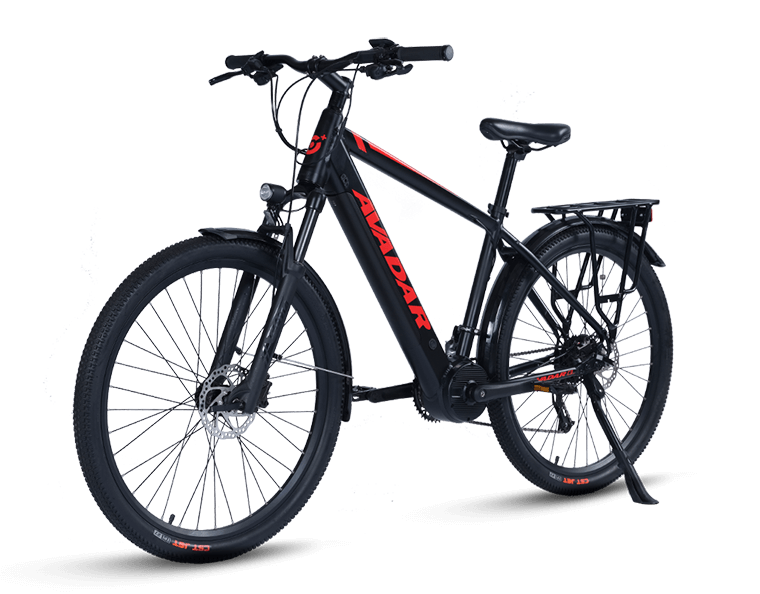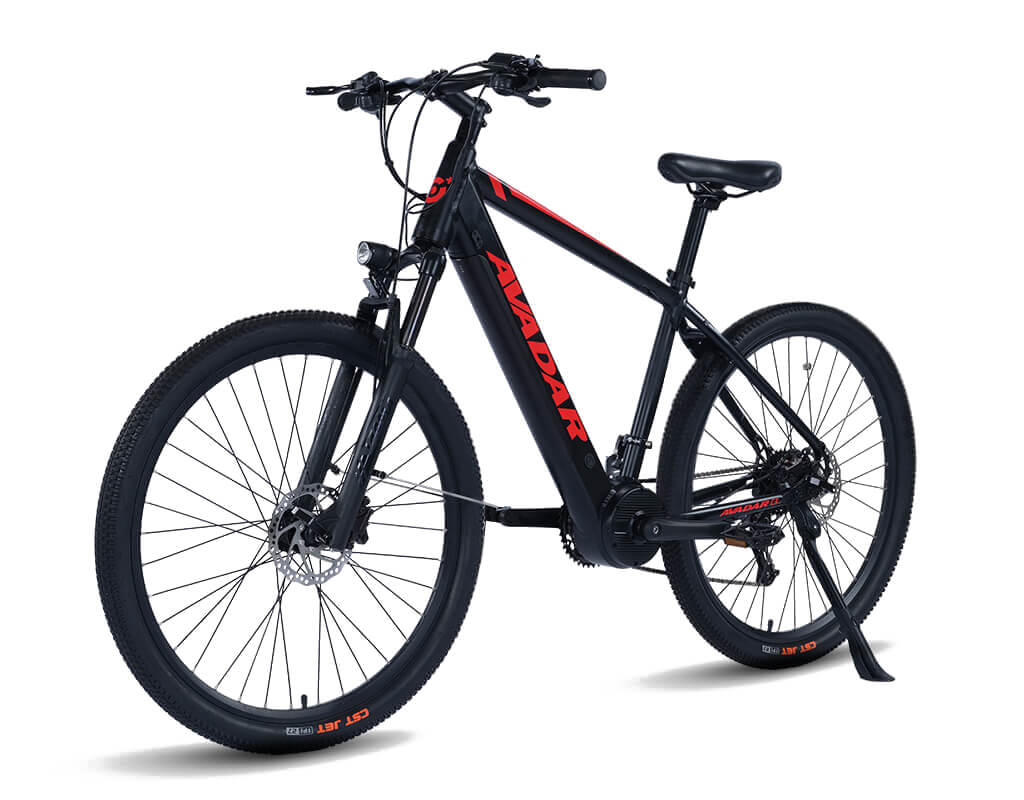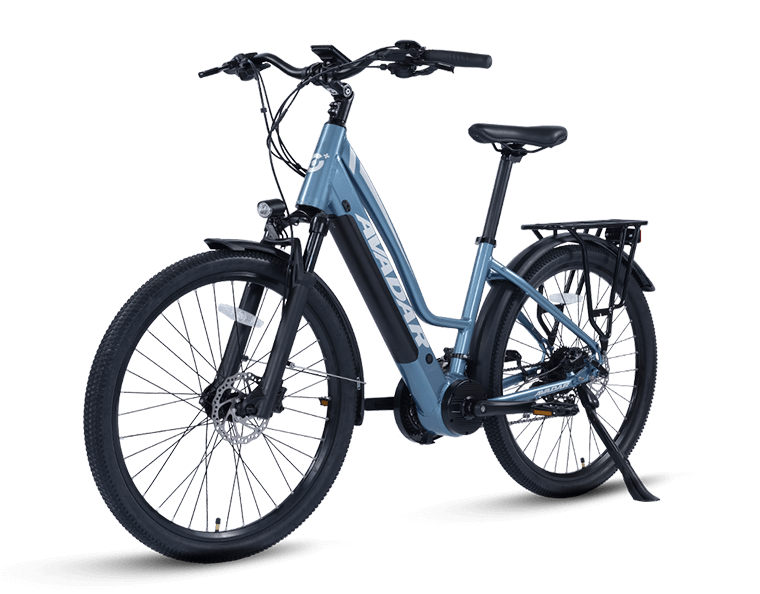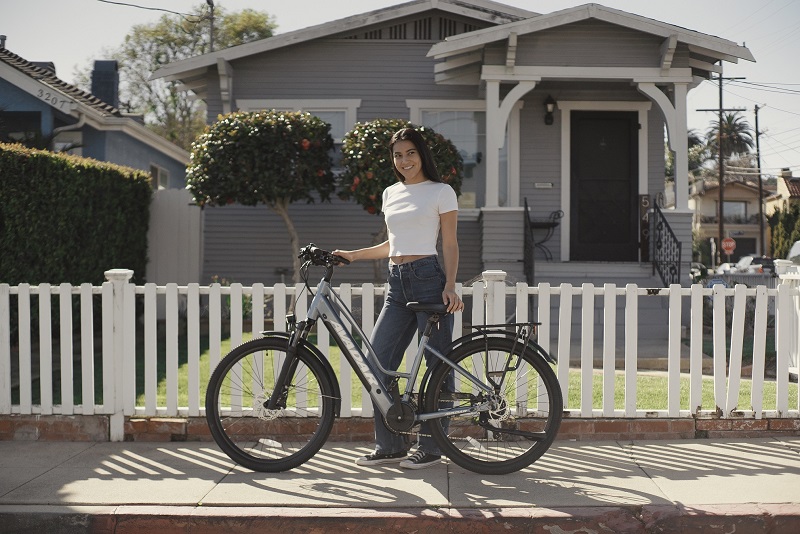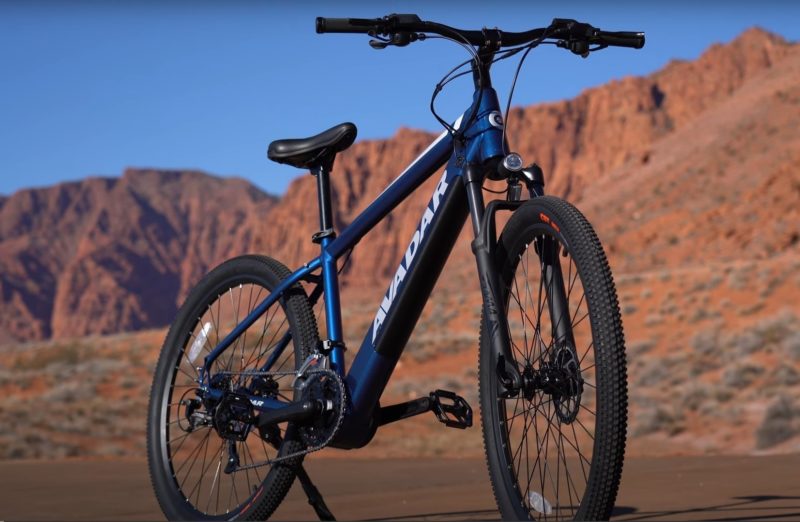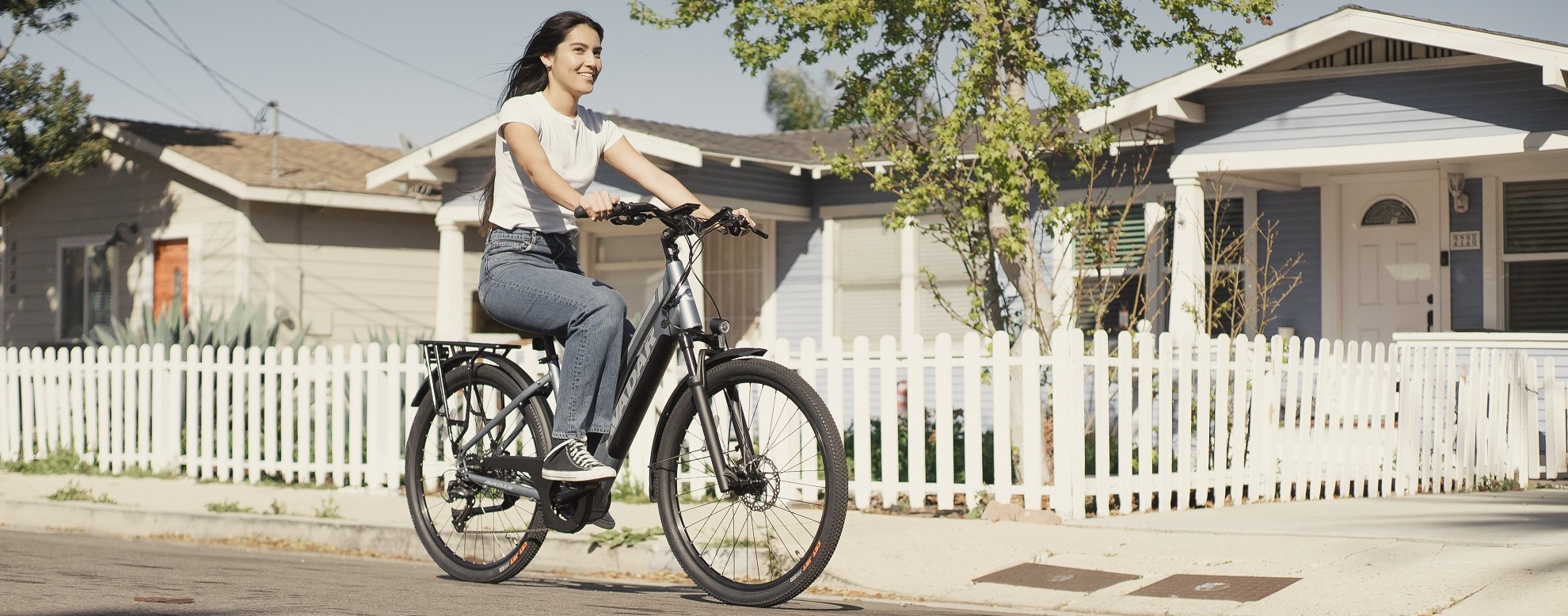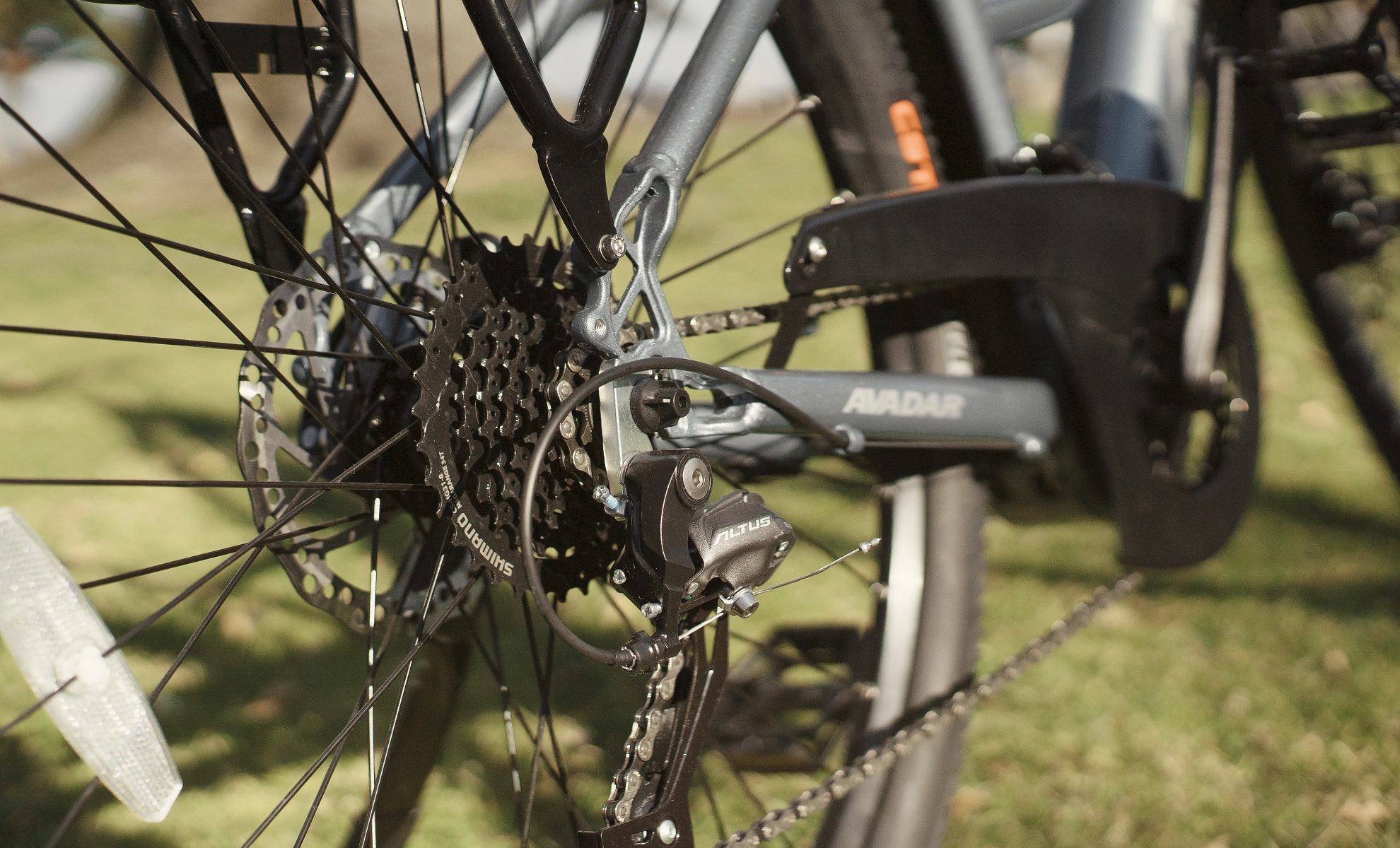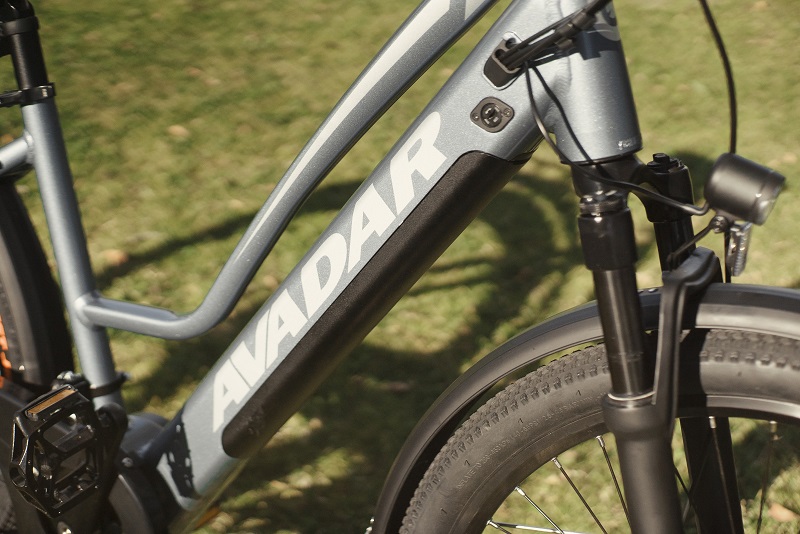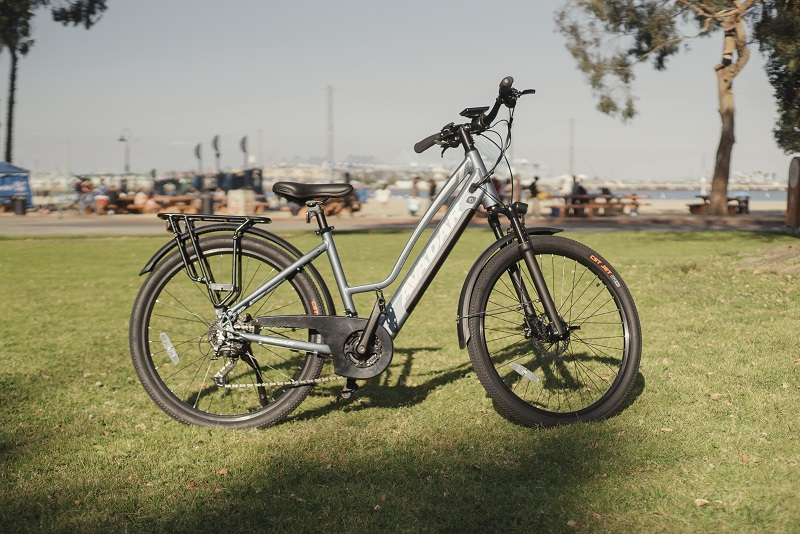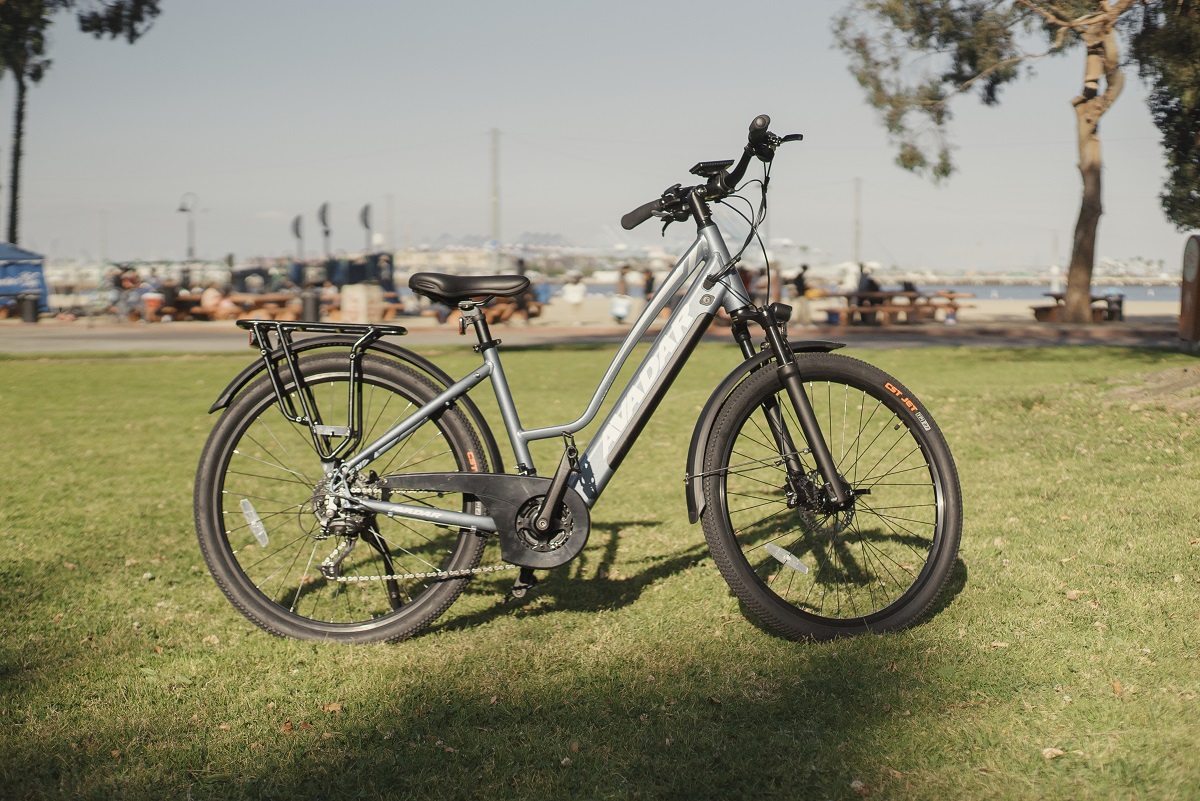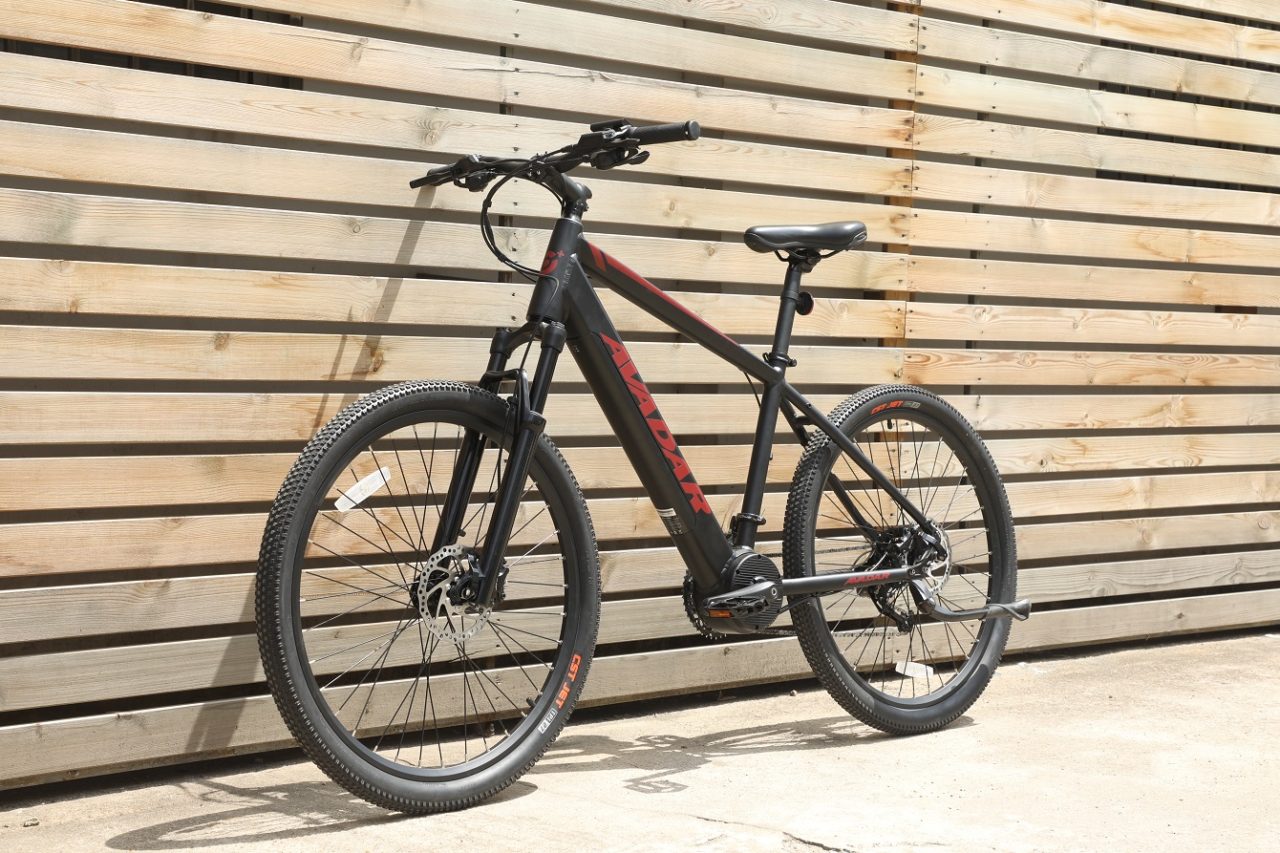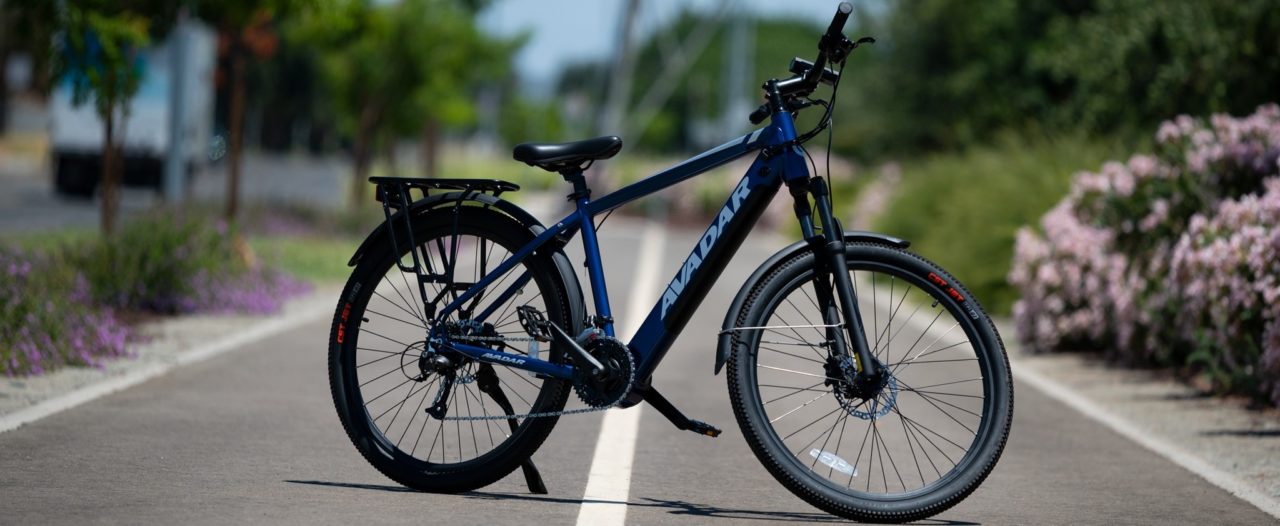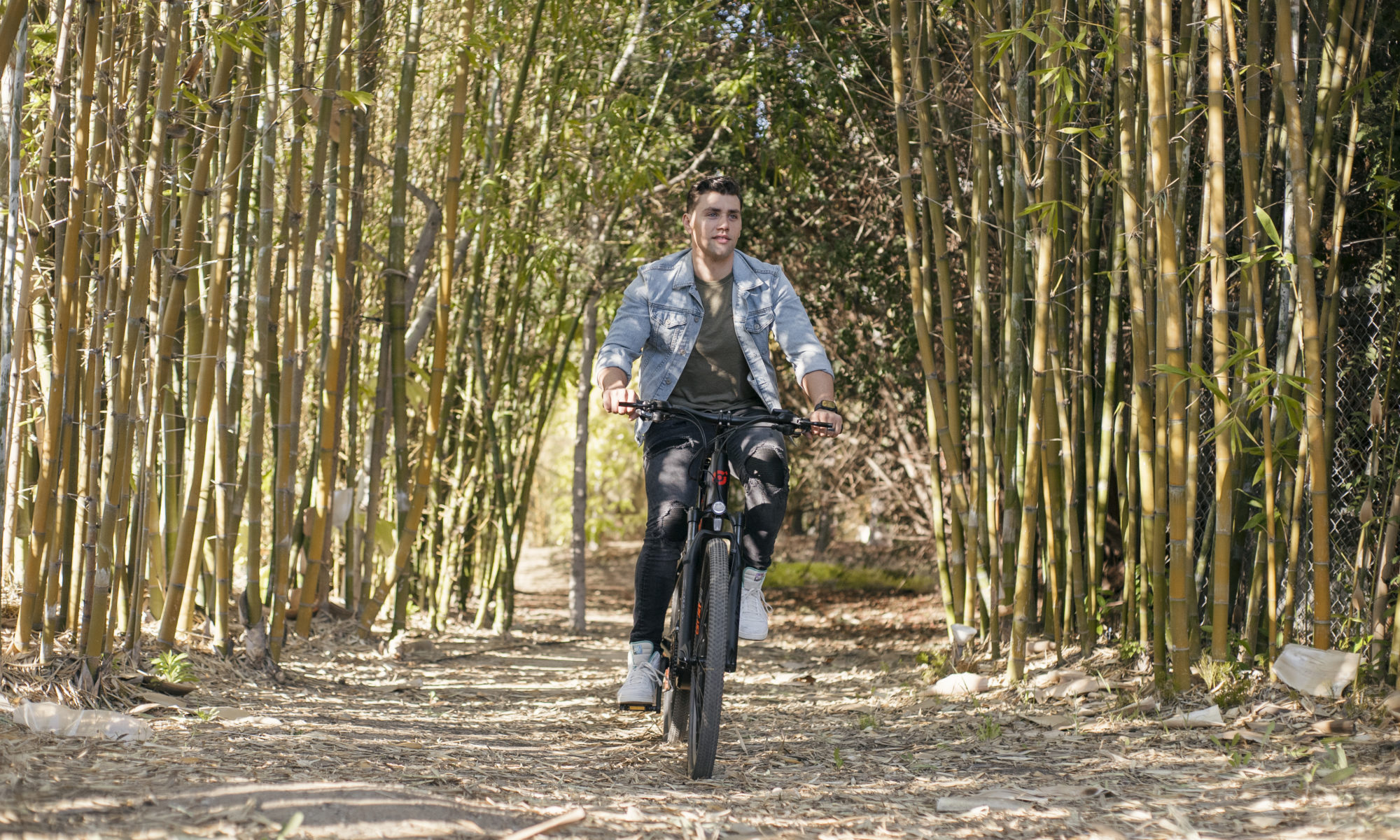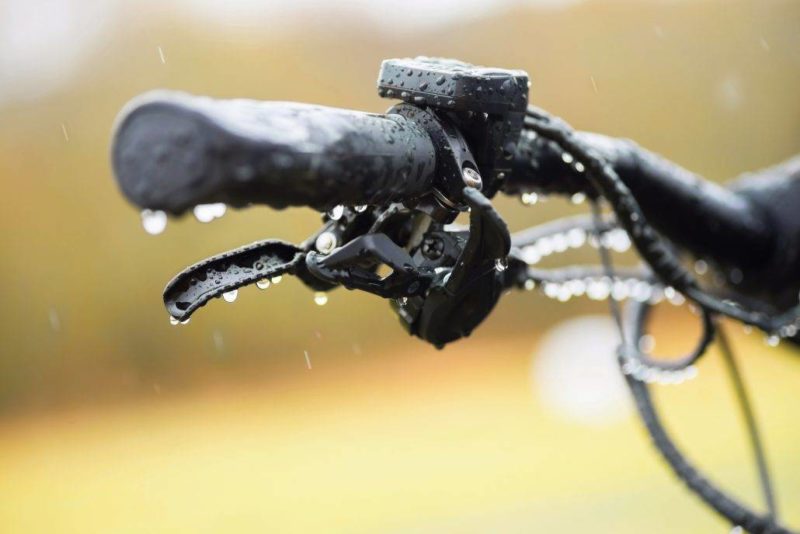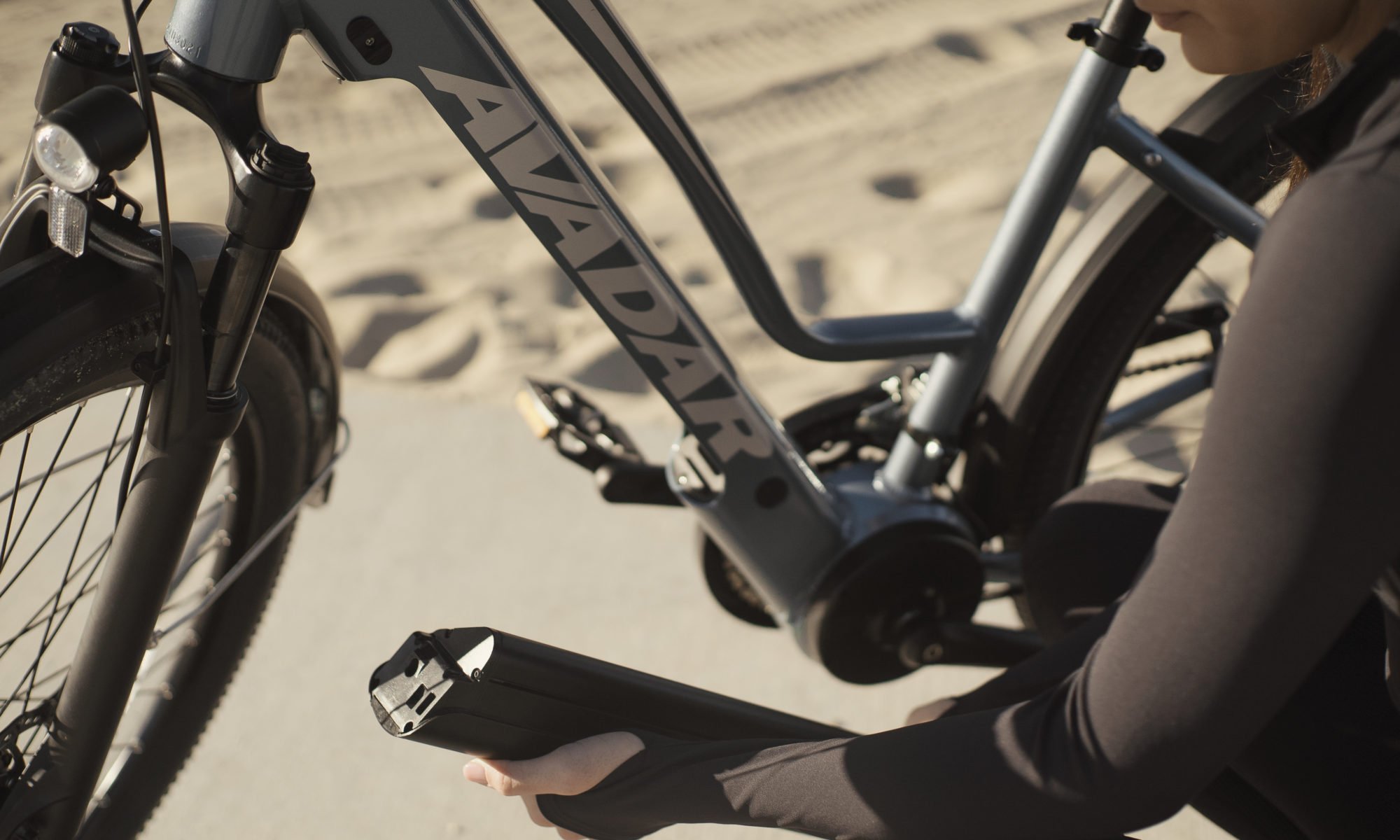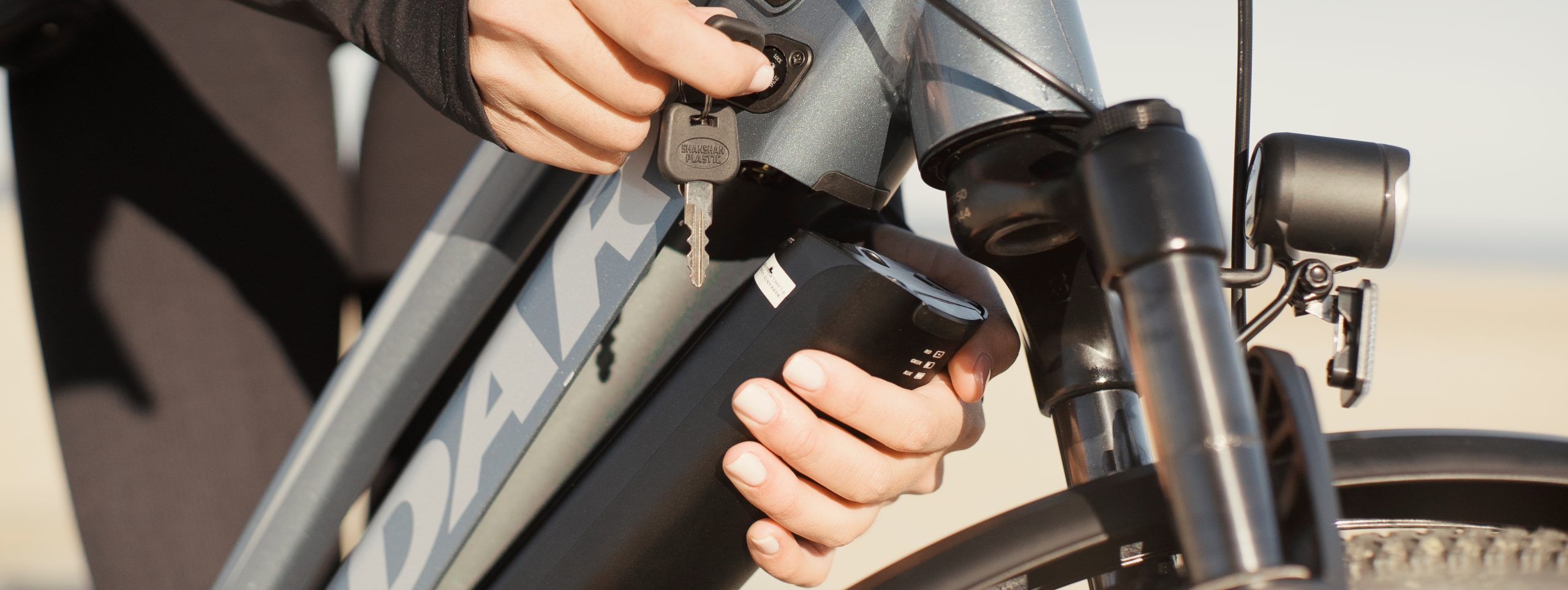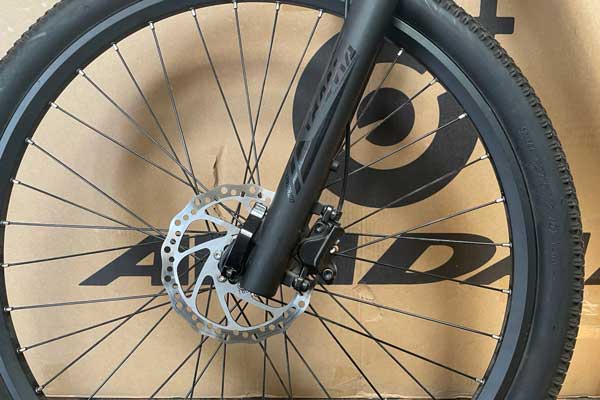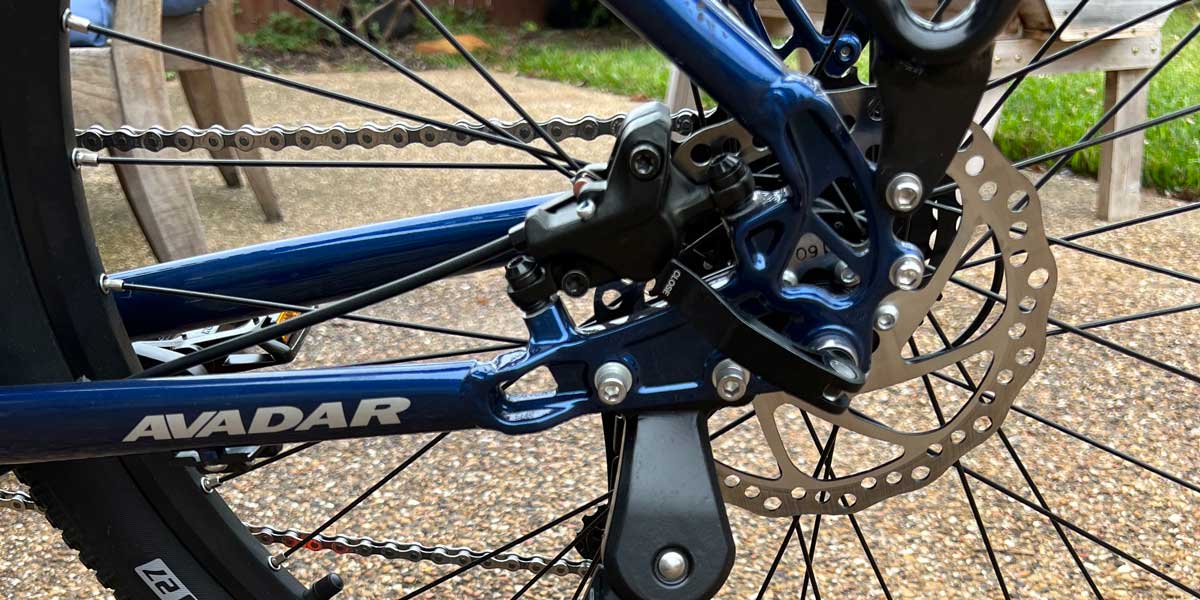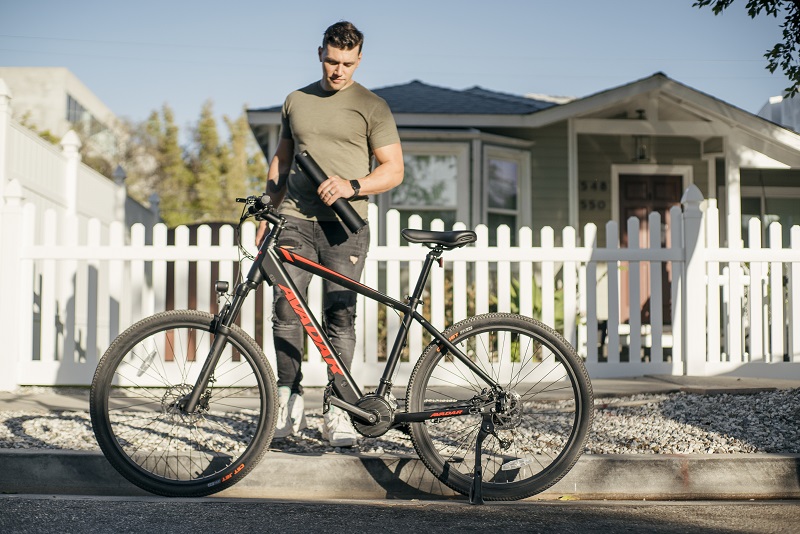
Choose Electric Bike for Women Wisely: 7 Bikes Types and 3 Best Principles
The electric bike for women is a reliable and ergonomic vehicle, which is not inferior to the male models in terms of technical characteristics. However, there are also very significant differences that exist in the design, which takes into account female physiology. Therefore, before buying you should carefully understand what are the main differences and how to choose the right bike for a woman.
What is the difference between an electric bike for women and men?
The first visible difference is the lowered frame. Unlike the men’s bike, the women’s frame is low. And all because the women’s bike is an invention from the distant Victorian era, when girls did not wear pants, but only long skirts. And so that the ladies could ride this means of transport, the design was slightly changed. By the way, in sports models, a beveled top tube can play the role of the frame. Another difference that can be seen at first glance is the color and design. Other features are its low weight. After all, it is much easier for ladies to maneuver on a lightweight bike and move it themselves if necessary. And since the weight of girls is usually much lower, the production of the electric bike for women uses a soft shock absorber. In this situation, girls cope better with bumps in the road. A stiffer fork simply cannot compress under ladies’ weight. As for the style of riding, like men’s bikes, they can be used both for leisurely walks and rides in the city and for professional competitions.
Choose The Electric Bike For Women By Purpose
Urban (city electric bike for women)
City bikes are designed for riding on urban streets and in parks. They are not designed for heavy loads. The city electric bike for women has 3-7 gears, a comfortable seat, large wheels, a high seating position, which is particularly easy on the back, and a hardtail. As a rule, the maintenance of such bikes is practically not required. Also in the configuration, you can often find – a trunk, chain guard, mudguards, foot brakes, etc.
Road Bike
This bike is characterized by a simple design, high reliability, and relatively low price. Ideal for trips in the countryside. Disadvantages include cumbersome, high weight, and low comfort (which leads to fatigue on long trips).
Mountain Bike
Universal means of transportation, suitable for both paved roads and forest trails. That is why it is the most popular among the other types. There are many subtypes: beginner bikes (for normal rides), freestyle bikes (for stunts), and downhill bikes (for mountain rides).
Speed Bike
This option is perfect for high-speed riding on smooth asphalt. Its design is specifically designed for maximum speed of movement. The functions of such a bike are speed, maneuverability and efficiency. The main advantage and feature is the lightness of the frame, wheels and all components. The steering wheel looks like “ram’s horns”. Wide wheels are safer, narrow wheels provide more speed.
Touring bike
This sub-type of the bicycle is a touring bike. It is designed for cycling. A special feature is the ability to attach a trunk and carry a bicycle backpack. Cleat brakes. The wheels are thick and wide, the frame is strong and light. The front fork is equipped with a shock absorber. The steering wheel looks like “rams horns”. Suitable for cycling on different roads.
Cruiser
A good choice for smooth rides on good asphalt. The top tube of the frame is low and there is a chain guard. The weight of such a bike is quite high. The saddle is wide, the gears are at least. There is a basket (trunk).
Hybrid
Combines the characteristics of hiking, mountain, and road bikes. They are characterized by the presence of a high frame, suspension fork, mudguards, disk brakes, and sometimes a trunk.
What to pay attention to when buying an electric bike fo women?
When choosing an electric bike for women should be guided by the main features. After you have decided on a model (purpose), you need to pay attention to the following points:
- Manufacturer. It is best to give preference to trusted brands that have many reviews on YouTube. Also, pay attention to the warranty, the more it is, the better. We offer a 2-year warranty on all our electric bike for women and offer a 14-day free return policy for your peace of mind.
- Size to Growth Ratio. The length of the frame, and accordingly the size of the electric bike itself, is selected according to the height of the girl. If you choose according to height, you should know how to determine the size of the frame. This is the distance from the bottom bracket to the intersection with the seat post, measured in inches, and is usually indicated under the seat (indicating the appropriate height). It is also important to check compliance in practice. To do this, you must stand on the bike so that the frame is between your legs. To be able to dismount and mount comfortably, the distance to the frame should be quite large. You should also not reach for the steering wheel unnecessarily. However, your back should still be slightly tilted forward.
- Frame. The understatement of the frame varies. There is a frame with which you can ride in a skirt without any problems and even with comfort. It is also preferable if the frame is made of aluminum, as this will ensure greater ease of transport itself.
You Might Also Like
Ride With Us
14 Best Gifts for Cyclists in 2022
To find the best gifts for cyclists, you must first decide how advanced the cyclist is. If it is a beginner, then you have a huge selection of everything you can give with real benefit. If the cyclist is already experienced, then it can be a little more difficult, but we will try to find options.
The list of the best gifts for cyclists
1. The bike itself
A bicycle is a gift for all gifts. If someone does not have a bike yet, but you have heard from them that they love to ride, then why not give them an electric bike, especially if you can afford it? Just do not buy a very cheap bike, or you will beat the desire to ride. Right now, the cost of a good electric bike starts at $1,500, trust us, it’s worth it. It’s hard to find a better gift. The C3 e-bike is a good start for everyone.
2. Bicycle helmet
It is probably one of the best gifts for cyclists. If your boyfriend, husband, or other relative does not have a helmet, do not break your head and give him a bicycle helmet. By doing so, you will save his head and maybe his health and life. No, no, we do not want to scare you, but there have been cases where a cyclist died when he fell at a speed of 5 km/h and hit his head unsuccessfully on the curb. Very cheap models are not recommended choose. The cost of an average bicycle helmet starts at $25 on Amazon.
3. Headlights (bicycle lights or reflectors)
Lights are the second most important safety feature for a bicyclist. When riding at night, as well as in cloudy weather, we strongly recommend riding with rear and front lights. The brighter they are, the better the cyclist is seen on the road. The cost of an average bike headlight starts at $25.
4. Compact tool set (bicycle multitool)
A very useful thing. Sooner or later something breaks on the bike and you are forced to use the tool. A bicycle multitool should be in the backpack of every cyclist. You should not buy a very cheap tool made of inferior materials. Also, make sure that the set includes the basic necessary tools: Hex wrench, screwdriver, chain puller, and spoke wrench. Multitools are always on our consideration list of the best gifts for cyclists. The cost of a bicycle multitool starts at $15.
5. Bicycle pump
It happens that a novice cyclist has not had time to get a pump, or is simply hoping for the opportunity to pump up a bike at a car service station or garage. If your cyclist does not have a good, compact bike pump, be sure to give him one. One day he’ll remember you with a kind word when he’s out of town struggling with an apartment tire. If the cyclist is already experienced, owns several bikes, and needs to change tires frequently, you can also give him a full pump, which every cyclist needs in the home. The cost of an average bicycle pump starts at $15.
6. Cycling clothing
Of course, cycling clothes are a personal matter and usually, everyone chooses them for themselves. But why not give some high-quality, nice things as a gift? Especially if you know the size and color preferences of the person. High-quality cycling clothes are comfortable, beautiful and a must for proper cycling. The cost of a standard set of cycling clothes (cycling shirt and cycling shorts) starts at $45.
7. Cycling glasses
Eye protection is very important, as the cyclist is constantly in contact with dust, dirt, water, snow, and insects that get into the eyes at the most inopportune moment. The most popular option is cycling glasses with a set of interchangeable filters in different colors. Darkened, colorless, yellow, mirrored – this is the classic option. It becomes more difficult when a person wears regular glasses. In this case, it is worth looking for a variant of cycling glasses with diopters. They are more expensive, but surely a person will appreciate your care. The cost of simple cycling glasses with interchangeable filters starts at $25.
8. Bicycle computer
Another option for the best gifts for cyclists. If someone has been riding a bike a lot lately, then a bike computer is a very useful gift. There are wired and wireless models with different numbers of functions. From simple with the most basic: current, average, maximum speed, odometer, to complex with GPS, cadence counter, heart rate monitor, and other useful functions. The cost of a simple wired bike computer with basic functions starts at $30.
9. Heart rate monitor
If you are thinking about the benefits of cycling, you should definitely have a heart rate monitor. It will allow you to train properly, not overload the body, achieve the maximum training effect and monitor the improvement of your physical shape. The cost of a simple heart rate monitor starts at $30.
10. Cycling gloves
A simple, cheap, but very useful gift, gloves probably are the best gifts for cyclists. Cycling is much more pleasant with gloves than without, especially in cold weather. You can give gloves with long or short fingers, depending on the season. The cost of cycling gloves with short fingers starts at $10.
11. Backpacks for bikes
If you decide to give a bike backpack as a gift, you first need to find out what style of riding the person prefers. If he likes one-day trips easily, then the best option would be a shoulder backpack up to 20 liters, bright colors, with a ventilated back and the ability to use with a hydration system (it is better to give it right with him). For lovers of multi-day trips, the best choice would be a trunk bag. The cost of an inexpensive lightweight shoulder backpack starts at $ 25 and $ 35 for the trunk bag.
12. Book
In the age of digital technology, books can be the best gifts for cyclists. After all, sometimes it’s so nice to put away the smartphone or tablet, step away from the annoying screen, sit in a comfortable chair and feel the magical rustle of the pages in your hands, smell the printer’s ink, and touch something you’ve already forgotten about but is so dear. If you search carefully, you can find gift options for books with a bicycle theme. There aren’t many of them, but they do exist.
13. Streaming subscription
If someone loves cycling and enjoys watching broadcasts, but does not always have the opportunity to sit in front of the TV, you can give them an annual subscription to one of the streaming services. Such a gift will allow you to watch all the broadcasts from your tablet or smartphone. A cycling fan will certainly appreciate such a gift.
14. A trip to the venue of a famous bicycle race
What cycling fan does not dream of visiting at least one stage of the Tour de France, the Giro, the Vuelta, or other world-famous races? This is a great gift that will be remembered for a lifetime. Just do not forget to arrange the dates with him in advance and especially where he wants to go.
What NOT should give a cyclist
Speaking about the best gifts for cyclists, regardless, we would like to bring to your attention some items that you should not give away for one reason or another. We will give examples and explain why it is better not to give them away. After all, we do not want the thing to gather dust unused. This is our personal opinion, and it may be different for someone else.
Bicycle lock
The fact is that the bicycle lock gives a false sense of security. Almost any bicycle lock can be cracked very easily. So if you give away a bike lock (especially to an inexperienced cyclist), you are not doing it a good service. The only and most reliable method against bicycle theft is not to leave your bike unattended. Recently, due to rising prices, the bicycle has become a particularly tasty prey for thieves.
Contact pedals
On the one hand, contact pedals may seem like a pretty cool gift. But keep in mind that many novice cyclists are not only unable to ride them, but may not even know they exist or what purpose they serve. Contact pedals are something you have to get used to. Also, special cycling shoes are required to use them. If it is a gift for an experienced cyclist, then most likely he already rides with contact pedals and knows what he needs.
A large set of tools
Large, expensive, but not always useful. The fact is that tool sets (cases) often contain many tools that most likely will never be needed for work, and are of very poor quality. If someone has just started cycling, most likely, he will first turn to a bicycle service, and if there is a desire to maintain the bike himself, he will buy all the necessary tools themselves.
Parts and components for bicycles are not the best gifts for cyclists
You should not give away bicycle parts unless you are very knowledgeable and know the model of the bicycle and the needs of its owner. Because the variety of bicycles is very large. Wheel diameter, frame sizes, mounting standards – everything can be very different.
The list of the best gifts for cyclists is endless. But in our opinion, the listed can be called the most popular and useful.
You Might Also Like
Ride With Us
Enjoy Bikepacking this Fall: 2022 Guide with Checklist
Overnight bikepacking is always interesting, even if you have done it a million times. Few things compare to being able to sleep right under the stars. Such trips are good for taking a break from the vicissitudes of life, spending time in a very simple way, and escaping stress.
A short bike ride of less than a full day is a small adventure that is quick, easy, and fun if you have the necessary equipment. It is not necessary to spend a lot of money on all this – it is enough to plan a few things in advance. In general, if you are ready, take a bike and make this little trip.
What is bikepacking?
Actually, bikepacking is about properly packing your bike with everything you need for a multi-day trip. Everything is about the same as normal hiking, except that here you have a bike with you.
Such trips are usually associated with autonomous travel to faraway places, although there are no rules for what can be considered real bikepacking. Everything is very simple: if you ride a bike and spend the night in nature, using only what you brought with you, then it’s bikepacking.
What is the difference between cycling and bikepacking?
Bikepacking is traveling on a road bike with a clothes bag, carrying everything you need. Such a trip can last several days, weeks, or even months.
Bikepacking is usually referred to as an off-road variant of bike tourism. Bikepacking bags and bikes usually suit the unpaved, gravel, and often mountainous trails on which these bike trips take place. Because of the more difficult riding conditions, participants tend to carry fewer items and use lighter equipment such as bivy bags instead of a tent with a sleeping bag.
What kind of bike do you need for bikepacking?
First of all, off-road travel requires a suitable bicycle. If you know that the route will have a minimum of asphalt and many bumps, then it is probably better to choose a gravel or mountain bike. As a precaution, not every mountain bike is suitable for this (for example, a downhill bike will not fit exactly), and you need to choose a bike that is suitable for both uphill and downhill riding.
How to find routes for such trips?
Of course, we like to plan unique trips ourselves, but sometimes it is good to entrust this to someone else. It’s nice if the first trip is not very far from home, in an area you know – in this case, you can test your equipment, and if you suddenly need to return urgently, it will not be a big problem.
To find routes, you can use special applications – for example, Komoot. There you can search for other people’s routes as well as create your own. We advise you to look at the total length and the gradient of the route before the tour – this way you will have a rough idea of how long the tour will take.
There is also a website like Bikepacking.com where you can find some routes that others have already tried. The site offers routes in different parts of the world, both for gravel bikes and mountain bikes.
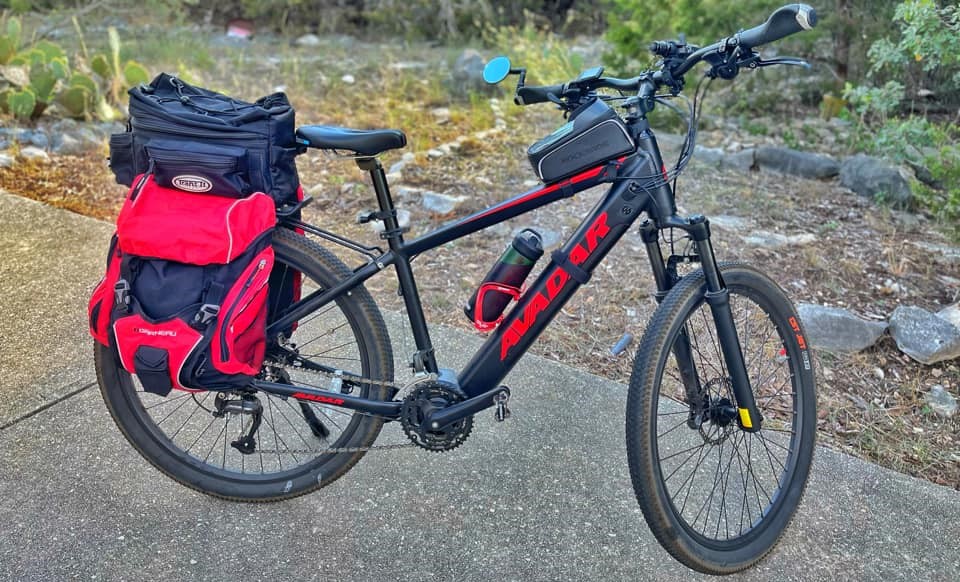
What equipment is needed for bikepacking?
You will need something to sleep in: a tent, a hammock, a bivy sack, maybe a sleeping bag and a mat. As for warm clothes, it’s best to take a little more than you need – just in case. And, of course, you’ll need bags to carry it all in.
What is best for sleep?
Lightweight bikepacking kits usually use bivy sacks or tents instead of tents and sleeping bags – they are not as bulky and weigh less. A bivy sack is essentially a sleeping bag with a waterproof shell, similar to a large sock. An awning is a piece of waterproof and windproof fabric that you hang over your mini-camp before going to sleep.
It’s clear that all of these options have their pros and cons: Some people prefer to sleep in an enclosed space (tent or hammock) rather than directly outdoors. Another factor to consider when choosing equipment is the weather. For example, if rain is predicted, you will probably still prefer a tent – so that all things stay dry.
Sleeping bag
Keeping warm while sleeping is an important task. You can not sleep well in the cold, so all you need is a good sleeping bag. Which sleeping bag is best depends on what temperature you are used to sleeping in and what the weather will be like at your destination. For example, an insulated winter sleeping bag is not the best choice for the Spanish desert in the middle of July.
The thinner the sleeping bag, the lighter it is, but this is where you need to decide if a thin sleeping bag is for you. Before buying, check if the sleeping bag is suitable for your hike and what temperature ranges it covers.
Bikepacking clothing
Temperatures always drop at night, and when you are out riding, you should warm up a bit. For example, woolens are good for keeping warm both when riding and sleeping. And if you are pitching a tent or blowing up a blanket, it’s a good idea to wear an insulated jacket – yes, that’s also a good addition for any bike enthusiast.
Ultimately, it depends on what kind of gear you need, whether you are warm or cold at night. But everyone has their own preferences here, and there can be no universal solutions – it’s just trial and error. After several trips, however, you will already know exactly what you need.
Bicycle bags
If you have already decided a little bit about the equipment, it would be time to decide what you want to transport it all. You can start with a modest bike bag. They are small but spacious and can be hung on almost any bike.
These bags are different, and here are some options that you can consider:
- – Saddle bag
– Handlebar bag
– Top tube bag
– Mounting bag in the front frame triangle
Saddlebags and handlebar bags are ideal for bulky items that you do not need while riding. For example, you can stow a sleeping bag, a bivy sack, or a wool blanket there – all that you get only before the overnight stay.
The bag on the top tube holds money, snacks, and other small items that you are likely to need on the road.
Finally, the pocket inside the frame is ideal for storing tools and spare parts. Of course, everyone hopes you will not need them on the road, but in case of an unexpected breakdown or damage to your camera, you need to have them with you.
Bikepacker checklist
The final list may be different for everyone, but you can start with our list, especially if you have no experience with it. In general, here is, the list:
- Sleeping gear: sleeping bag, tent/hammock/bivy sack, mat.
- Clothing: skating clothes plus thermal underwear, padded jacket (preferably synthetic so you do not freeze even when wet), hat, socks for camp.
- Cycling accessories: helmet, running shoes, bicycle lights, bags.
- Batteries or power bank, cable.
- Headlamp (it is useful when you pitch a tent in the dark).
- Food and water (think in advance about what you will eat for breakfast and lunch and how you will prepare it).
- Hygiene items: Toilet paper, toothbrush, and toothpaste.
- Tire repair kit and tools.
- First aid kit – anything can happen!
That’s all – now you are ready for the first overnight bike ride.
Once you have decided on a route, gathered all the equipment, and prepared the bike, you can finally set off. If you are tired of traveling alone, you can always take friends along. Because the only thing better than skiing with friends is skiing followed by an overnight stay.
You Might Also Like
Ride With Us
Electric Bike Maintenance and Security Tips 2022
If you want your electric bike to give you many years of pleasure, you should take care of its safety and maintain it properly. In this article, we will go over the main points of safety and proper repair of an e-bike.
carry tools to repair your electric bike
Do not forget to carry a repair kit for an apartment tire.
If you are willing to ride your bike long distances from home, be sure to carry a repair kit necessary to fix an apartment tire.
There are a large number of repair kits on the market that are necessary for repairing bicycle tubes and tires. But not all of these repair kits contain the necessary tools and supplies to fix an apartment tire. Here is a list of repair kits that you need to repair a punctured bicycle tire yourself:
- Mounting bead (needed to remove the tire from the rim or to pull the tube out of the tire).
- A set of patches to seal the bike’s chamber. As you may have guessed, this is a set for patching an apartment tire. This set contains patches of different sizes that you can use to seal any hole in the tire. In extreme cases and if necessary, you can also use it to seal the tire itself.
- Hand pump for inflating a bicycle tire.
- Spare bicycle tube. Many cyclists prefer to carry a spare inner tube so that in the event of an apartment tire or tube, you can replace the damaged one with a new one. In this case, the entire repair process does not take much time, and you can later seal the punctured chamber at home at your leisure.
- Bicycle tools. As a rule, open-end wrenches and screwdrivers of various sizes and types are the more practical multifunctional tools for a bicycle. Of course, this depends on the type of bike you have. Depending on the make and model of the bike, you may also need a special repair tool. First of all, when choosing tool sets, remember that you should always have a bike repair wrench with you.
That’s basically all the tricks with the tools. You can always take these items we mentioned with you, putting them in a backpack or under the bike saddle (if there is a special place there), for example, and the pump can be attached to the frame. You can also equip your bike with a trunk to which you can attach the bag in which you can store all the things and tools you need.
If you are traveling far from home with your bike and plan to change the tube in the bike itself in case of a puncture and seal the resulting puncture on the bike, you should always remember that you must have experience and skill to do this. So if you have never changed the tube of a bicycle yourself, you should do it at least once at home.
Replacing the chamber in the wheel with the help of a tool is quite simple. But if you have never done it before, it will probably be difficult for you to quickly change a wheel on the road.
We also draw your attention to the fact that the above list of tools and repair kits is only for trips within the city. If you are going far from home outside the city and plan such a trip across the country, in this case, you will need an additional set of necessary items for bicycle repair.
Always check the technical condition of the electric bike before a ride
Before you set out, be sure to check the performance of all bicycle systems. First of all, you need to check the performance of the brakes of the bike.
If you use your bike every day, you do not need to do this because you already know that the brakes are fine. But if you only ride your bike on weekends, you need to check the brakes for proper performance before such a ride. To do this, lift one wheel, turn it vigorously, and then apply the brake forcefully.
Also, always check the pressure in your bicycle tires before embarking on a long trip. If the pressure in the tires is too low, you need to inflate them before riding.
Protect your bike with a bike lock
Bicycles are stolen by the thousands in our country (and not only there), every day. If you do not take care of the security of your bike, sooner or later it will be stolen. If you ride your bike to stores, restaurants, or cafes, or use your bike directly as a car, you need to take care of proper locking of the bike yourself, protecting it from theft in your absence.
The best type of lock to protect your bike from theft is the U-lock. The most important thing to remember is this. All combination or cable locks can be easily broken or picked.
Try to always park your bike in a public place. Your bike should be parked on a bike stand next to other bikes.
We also recommend that you do not leave bags, backpacks, or lighting equipment with your bike, as burglars can steal all these things in your absence.
As with any hobby, there are many tips and tricks that we cannot fully cover within the scope of this guide. Therefore, dear friends, we do not claim that our material should be your only guide to cycling in the city. You can certainly find a lot of useful information on the Internet that can help you. For our part, we have tried to summarize in this publication simply everything that is most necessary and useful for cyclists, that is, everything that many of you need to know today, how to move by bike in a big city.
If you have become accustomed to your bike when moving around town, you are probably ready for something more. For example, you’ll be ready for contemplative trips and mountain roads or cross-country rides outside the city. A bike may become more important to you than a car, or maybe your hobby will turn into something bigger. Always strive, gentlemen, for perfection and something more.
You Might Also Like
Ride With Us
An Electric Bike for Adults: 4 Main Things to Consider
It is not easy to choose an electric bike for adults. In this article, we will try to give you an ultimate guide and answer the most common questions. Older people often lead a sedentary lifestyle, spending more and more time in front of the TV over the years, not doing any sports, and moving very little. A wrong lifestyle negatively affects adult health, promotes the development of diseases, and often makes older men and women depressed. At any age, it is necessary to stay active. The remedy recommended by doctors to lift mood is cycling, which can be done at any age. Fresh air improves the general mood.
What should be an electric bike for Adults?
Regardless of whether you choose a tricycle, a two-wheeler, or an electric bike for seniors, you need to consider the safety and comfort of older people getting around. Men and women in their 50s often have musculoskeletal disorders due to their advanced age, over the years they lose joint mobility and coordination, so the choice of transport must be made consciously.
Requirements for an electric bicycle for adults:
- Lightweight: allows an elderly person to take the bike without assistance and set it up again after a walk; it is easier to manage such transportation;
- The low step-thru frame is recommended – facilitates the technique of landing and getting off;
- The vertical position of the body when riding – given the limited coordination of movement in the elderly and weak muscles, you should avoid steering the bike on an incline, as this requires increased effort;
- Suspension is necessary to maintain the health of the back – good suspension absorbs possible shocks and bumps when going over uneven sections of the road;
- Non-slip tires, comfortable steering wheel;
- Saddle: buy models with a soft, comfortable, and wide saddle, as the comfort of an older athlete and the proper distribution of the load on the legs depend on its structure.
An electric bike for adults should not develop high speeds, transportation is designed to overcome distances at a moderate pace, safe rides, and feasible cardio loads.
The advantages of cycling
Riding a classic bicycle or an electric bike develops all the muscle groups of an adult. With the help of cycling, you can lose excess weight, correct your figure, make your joints more flexible, etc. To achieve your goals, you do not need to complete marathons or develop high speeds, it is enough to move at a steady pace and walk regularly for 1-2 hours. Cycling rejuvenates the body of a man and a woman by 25 years – scientists have come to this conclusion.
Here are some of the benefits of cycling:
- Strengthening the cardiac system, preventing congestion due to oxygen saturation of tissues, and improving blood circulation;
- Reducing the risk of developing vascular pathologies and coronary heart disease;
- Training of eye muscles and attention – while driving, attention is required and you often have to change the focus of your eyes;
- Good mood – regular trips to the fresh air improve physical health, have an effect on the general mood, promote discipline and make you rethink your attitude to life.
To ensure that bicycle and e-bike rides evoke only positive emotions, it is worth planning a route away from the roadway for adults. Breathing exhaust fumes are dangerous to health. A suitable place for cycling is equipped with paths, parks, squares, and forests. Here, all the conditions have been created so that an active activity brings benefits and positive emotions. To avoid falls and injuries, take safety precautions, ride on the right side, choose easy routes, and do not plan trips in the evening hours. Talk to your doctor before you start cycling, as many health conditions require limited physical activity and extreme caution.
How to choose an electric bike for an adult
Modern production is aimed not only at the younger generation, but more and more models of bicycles are appearing on the market, which are adapted to the needs of older people and are suitable for a comfortable and safe ride at a moderate pace. In addition to the above criteria, when choosing you need to pay attention to the accessories and equipment that you need to buy for seniors:
- Lock: to protect the vehicle from theft, keep it in a locked room and use special parking devices during forced stops and secure the bike with a lock;
- Trunk: older people often use an electric or classic bicycle to do shopping. To store the purchases, you need a spacious trunk, which should be located in the front or rear, depending on the model;
- Front light: even if older people should avoid riding at night, it is better to buy models with lights to ensure good visibility just in case;
- Helmet: even if you ride slowly, you should not neglect protective equipment, because in certain situations it can save lives or protect against serious injuries;
- Knee and elbow pads: an optional but recommended protection for older men and women to protect your joints in case of a fall.
When buying an e-bike for elderly parents, the requirements remain the same. Do not choose too “nippy” models, the optimal speed for the elderly is up to 25 miles per hour. You must buy a vehicle in official stores, where you can count on the help of customer support. It is better to refuse to buy a used vehicle, you will probably have to pay a lot of money for repairs, besides, the reliability of two- or three-wheeled such bikes remains in question.
Two- or three- wheeler?
A successful model for older people is a universal two-wheeled ladies’ bike with a low frame. This is a good solution for those who can already ride, keep their balance, have sufficient coordination, and are ready to tackle new routes. Those who are not confident in the classic design can try the electric or mechanical tricycle popular in Europe – a tricycle for the elderly, often used by European retirees. The growing popularity of getting around on three wheels is due to several design features:
- The additional stability provided by an extra wheel – the elderly person does not have to make an extra effort to maintain balance, you can stop at any time to rest without fear of falling when dismounting;
- Most models are equipped with a low frame to improve the fit; three-wheeled bicycles are a good solution for people with disabilities, for people with disabilities suffering from pathologies of the musculoskeletal system;
- Three-wheeled bikes are designed for increased load capacity and allow transportation even for people with excess weight;
- The design provides for a spacious basket, in which it is possible to carry not only bags with food but also small pets;
- Short frame – the type of frame used ensures a correct anatomical posture of the body, which evenly distributes the load on the spine and the person does not feel fatigued and pain in the joints even after prolonged use;
- Bicycles with three wheels guarantee excellent riding comfort, the seat is wide enough, and in some cases, there is a supportive backrest.
Three-wheeled bicycles with outboard electric motors differ from conventional scooters by their ergonomic design and help save fuel, lubricants, and maintenance costs. Noise emissions and pollution are minimal, making transportation attractive to those who care about the environment. Despite the impressive list of benefits, purchasing a trike is an expensive pleasure, as there are often problems with storing and transporting the vehicle due to its large mass and dimensions. It can be difficult to fit bulky models in standard passenger elevators available in apartment buildings, trikes do not fit in the trunks of cars. Because of the high center of gravity, tricycles can tip over on one side, increasing the risk of injury. Everyone has the right to decide for themselves which of the proposed models is suitable for them, it is important to learn about the advantages and disadvantages of the chosen means of transport before buying.
You Might Also Like
Ride With Us
E-bike for Adults The Ultimate Guide 2022
Many elderly people are still active despite their age, but pedaling becomes more and more difficult as the years go by. In this case, the electric bicycle comes to the rescue, gaining popularity and offering an excellent way to not only get more exercise but also maintain good health for many years to come. The information in this article will help you find the right e-bike for adults.
Advantages of an e-bike for adults
Electric bikes have their own advantages for elder people, which distinguish them from other means of transport and conventional bicycles:
- ● An electric bike allows you to get more exercise without overexerting yourself – it’s a great way to ride in the park or square, meet family and friends, and enjoy walking to the fullest.
- ● You can drive to work or the grocery store if you have to walk far, but driving is not worth it due to traffic or parking issues.
- ● A trip to a picnic or fishing will give maximum pleasure to the owner of an electric bike – with an electric bike it is easy to climb a hill, and everything you need can be stored in the trunk.
- ● Low power e-bike does not require a driver’s license, so it is affordable even for those who have never driven a car.
- ● Allows you to save considerable money, which is not unimportant in retirement.
Health benefits for the elderly
Although the e-bike can ride purely electrically (without pedals), it also has pedal assistance, and our C5 mid-drive step-thru e-bike has 5 levels. According to NCBI research, this allows older people to stay in the good physical condition and experience positive changes in other areas as well:
- ● Better mental health. Trips to nature help replenish vitamin D levels, which improves mood and lowers stress levels.
- ● The immune system is strengthened. Cycling cleanses the lungs and speeds up metabolism, which strengthens the immune system and reduces the risk of colds and flu.
- ● Slowing the aging process. Cycling allows you to maintain muscle mass and strength.
- ● Less stress on joints. Unlike running or walking, cycling puts very little stress on the joints and even less on an electric bike.
- ● Better coordination. Cycling improves posture and coordination.
- ● More communication. Get out of the house, make friends, and participate in mass events.
Types of electric bikes suitable for adults
Let’s take a look at the main types of electric bikes you should buy for an older person:
- ● City electric bike – suitable for riding on asphalt in the city, including parks and squares. It differs from the mountain e-bike by a more vertical landing.
- ● Three-wheeled electric bike – more suitable for people who’ve difficulty maintaining balance on a two-wheeled bike.
- ● Electric fat bike – designed for riding on rough terrain and unpaved surfaces. In addition to the classic two-wheelers, there are also electric fat bikes with three wheels and foldable models, as well as models with four-wheel drive for heavy loads. A great option for fishing trips or in the woods.
- ● Folding electric bike – convenient to store in a small space and transport by car. The folding frame allows you to fold the bike in half, significantly reducing its dimensions.
The main criteria for choosing an electric bike for the elderly
Before choosing an electric bike, you need to know the main criteria that a bike for the elderly must meet:
● Safety. The rider’s seat should not be too high to avoid falls and injuries. An e-bike must be equipped with effective brakes that allow you to stop quickly in case of an emergency.
● Comfort. A low frame makes it easy to get on and off, and a comfortable seat and handlebars at the right height keep you comfortable. Good padding on the bike is necessary to protect joints. The controls on the handlebars, such as the throttle and brake levers, must be easy to reach.
● Reliability. The bike’s frame must be sturdy, and components and attachments must be of sufficient quality to ensure long-term trouble-free operation. In combination with puncture-proof tires, the maintenance requirements for the e-bike are reduced to a minimum.
Tips and tricks for the selection of e-bike for Adults
Look for additional features before buying an e-bike for adults:
- ● Load capacity. Indicates the maximum weight the bike can support. If exceeded, the frame may not be able to withstand the loads over time.
- ● Wheel width. Wide fat bike tires provide high lift and additional cushioning, while narrow city bike tires provide good rolling.
- ● Weight. If the e-bike needs to be led up a flight of stairs, it should be light enough for an elderly person to operate alone.
- ● Light. If you use the bike at night, you will need headlights. They should be powered by the main battery. The presence of reflective elements is also useful.
- ● Mudguards. They are needed to protect the cyclist from splashes and mud under the wheels, and full-size mudguards do a better job than cantilevered mudguards.
- ● Trunk. If you plan to carry groceries or other items on an electric bike, choose a model with a trunk or with options to install one.
Electric bicycles for the elderly
As an urban electric bike for the elderly, you can consider the C5 model. It has a low frame that allows you to sit comfortably on the bike and an adjustable handlebar stem that allows you to adjust the bike to your needs and achieve the most comfortable fit. The bike has a luggage rack, full-size mudguards, and a headlight.
If you are considering fat bikes, then the Bezior XF001 can be an excellent option. It has a comfortable fit, a padded saddle, and even a long seat that you can put your grandson on.
Want to buy a compact electric bike that’s easy to store and transport? Look out for the Bezior XF200 foldable electric bike. When folded, it can be conveniently transported on public transport or in the trunk of a car.
You Might Also Like
Ride With Us
How to Clean Your Electric Bike
We know that taking care of an electric bike sounds like a boring task, there is not much to add to that, and in most cases it is. But cleaning is a very important process that must be taken seriously, otherwise, you could permanently damage your electric bike.
To wash your bike properly, you do not need a lot of time. You just need enough space, patience, your favorite music, and some cleaning products.
It’s not only about riding a clean electric bike, but also about safety because too much dirt accumulated in the brakes or battery compartment can lead to a serious accident.
How often should I Clean my electric?
There is no exact answer to the question of how often you should clean your e-bike. It depends mainly on how often you use it in a week, what kind of terrain you ride on and what time of year you use your e-bike.
For example, an electric bike will not get that dirty if you use it twice a day in the city, but if you have to ride it through mud, rain, snow or sand, then you need to wash it at least once a week.
If you rarely use your bike, you can wash it once a month, at most once every two months, but do not extend this period. Dirty water, dirt and other particles tend to stick to the chain of the e-bike. This will make pedaling more difficult and damage the chain.
Washing an electric bike every weekend sounds tedious, but when we think of the benefits of doing so, a bucket and a sponge seem to be our best friends.
What do I need to wash my e-bike?
The first thing you need is patience. Especially if you are doing it for the first time. The second thing you need to clean your electric bike is space.
It could be your yard, your garage, your garden,… anywhere you can fit your e-bike and still have enough space to move around comfortably without making a mess.
Once everything is settled, you will need the following things:
- Bucket filled with water
- Soap or bike cleaner
- Sponge and brushes
- Disk brake cleaner
- Bicycle degreaser
- Chain lubricant
- Owner’s manual
- Polyethylene film
Preparing the electric bike for cleaning
- Check your electric bike’s owner’s manual to see how much water it can handle. Usually, this value is indicated on the first pages of the manual with the letters “IP”, the higher the number, the more waterproof it is. However, if the number is low (for example, 38 or less), it is better to leave the hose on, because too much water pressure can damage everything inside.
- Remove the display (if you have one). If you cannot remove it, for example because it is attached to the steering wheel, cover it with plastic film to protect it from water.
- Remove the battery. The manuals usually say that you can leave it in place as long as it is protected enough not to cause a short circuit. After all, electric bikes must withstand harsh weather conditions such as rain and snow, but to avoid minor complications, we advise you to remove the battery.
- For more comfort, you can turn the e-bike upside down so that it rests on the handlebars and the seat. You can also cover both parts with plastic wrap to protect them from water. This way you can turn the wheels comfortably without destabilizing the e-bike itself.
Electric bike cleaning
- Start cleaning your electric bike with water. Use a small glass to scoop water from a bucket, or use a garden hose.
- Then you can clean it with a small rag or brush to remove dirt from hard-to-reach places like pedals, between tires, and brakes.
- Do not worry if water gets into the battery compartment because it is equipped with small internal drainage channels. The plugs are sealed with a special material that protects them from water, corrosion and general damage.
- Clean the gear (chain, sprockets, cassettes, front derailleur) with a bicycle degreaser. Leave the cleaner for 5 minutes and then wipe it with a damp cloth or thick paper, but proceed slowly to reach hard-to-reach places.
- Now go to the brakes and clean them with disk brake cleaner. Wipe them slowly and try not to use homemade cleaners. They usually have a bad effect on the performance of the brakes.
After cleaning the e-bike
Use a dry cloth to remove water residue from the bike. Do this patiently, because if you leave small traces of water or moisture, your bike will become even dirtier in a shorter time. Pay special attention to the battery compartment. Before you reinstall the battery, the battery compartment must be completely dry.
Now that you know how to clean an electric bike, there are no excuses! All you need is a little patience and a few things you can easily find at home or the nearest hardware store. Take good care of your electric bike, you’ll not regret it.
Can you ride an e-bike in the rain?
E-bikes are increasingly used for daily commuting, travel, and outdoor activities. Owners of e-bikes ride them in the city and beyond, on asphalt and off-road, in all seasons, even in winter, and in a variety of weather conditions. Of course, the most comfortable and safest ride is in nice weather. That’s why many cyclists switch to cars or public transportation on rainy days.
In this way, they protect their bikes from water and dirt, and themselves from the difficulties of riding in bad weather, and washing and drying the e-bikes afterward. But what if the rain catches the cyclist on the way, or the alternative to the electric bike is not considered? Today we will discuss whether it is possible to use an e-bike in the rain, how safe it is, and what precautions should be taken during such a ride.
Rules for using an e-bike in rainy weather
The motor, battery, display, and other electrical components of the e-bike are housed in sealed enclosures, so they are not afraid of moisture. However, the degree of protection of parts from moisture varies. For better protection of the battery, it is recommended to use a waterproof housing, lubricate the terminals and contacts with water-repellent and anti-corrosion grease, and apply silicone sealant to the contacts.
To minimize the effects of precipitation, it is important to take the following precautions when using your electric bike in the rain
- The e-bike can be ridden safely in wet weather and light rain, crossing shallow puddles easily. The most important thing is not to ride in fog, poor visibility, thunderstorms, downpours, or hail, avoid deep puddles, dangerous maneuvers, high speeds (more than 25 mph), and sudden braking. A puddle is considered deep if the water can reach the height of the motor or other electrical components when passing over the puddle.
- Moisture is dangerous not only because of the danger of a short circuit but also because of the corrosion of the terminals and contacts. Corrosion disrupts contact between nodes, affects the stability of their operation, and increases the risk of breakage. To prevent this, use special lubricants.
- Visibility deteriorates in bad weather. Therefore, it is important to use headlights and reflectors to make the e-bike as visible as possible to other riders.
- On wet roads, controllability decreases, the grip of the wheels on the road deteriorates, and the braking distance increases significantly. Therefore, in the rainy season, it is necessary to drive carefully, without acceleration, dangerous maneuvers, and sudden braking, avoiding, if possible, all kinds of obstacles on the way, puddles, and places with wet leaves or stones. On slippery surfaces it is easy to lose control, fall, damage the vehicle, or get injured.
Tightness of electric bicycle components
Before using the e-bike in the rain, you need to make sure that its components are protected from moisture. Most electric scooters and bikes are IP54 rated, which means they are fully protected from dust and splashing water from any angle. After being exposed to rain, the sensitive parts of such vehicles must be wiped and dried.
If the e-bike gets into the water
The hermetic design of all nodes IP54, IP55, or even IP56 is not a reason to ride an e-bike into the water. If it gets into a river, lake, stream, or deep puddle, water can cause the electrical components to short circuit. If an e-bike with a moisture protection rating below IP56 gets caught in a rainstorm or falls into a puddle, measures must be taken to eliminate the risk of a short circuit and breakage of electrical components. For this you will need:
- Turn off the power and leave it off until the components are dry.
- Thoroughly dry the electric bike.
- Disconnect the battery and place it in a warm room for at least one day.
- if possible, remove the controller cover to allow proper ventilation and drying.
- Go to a service, especially if you suspect that water has penetrated the electronic components.
By following these simple tips, you can avoid premature wear and tear on your e-bike equipment.
8 E-bike Battery Tips for Longer Life
With proper care, an e-bike battery will last a thousand charges or more – that’s three years of riding time if you use it for a week each cycle. If neglected, however, even the best e-bike battery will give out and die much sooner. And considering that high-quality e-bike batteries don’t come cheap, it’s in your best financial interest to give them plenty of love and care.
Here are eight simple tips to extend the life of your e-bike’s battery:
1. Keep Your Service Schedule
Keeping up with your e-bike maintenance schedule is essential to maintaining a long-lasting battery. We recommend bringing your e-bike in for maintenance every eight months, but also a little less frequently if you don’t ride it every day.
2. Use The Right Mode At The Right Time
Are you a fan of throttle mode or pedal assist? Our electric bikes have both options built into the motor.
In either case, you should weigh when to let the motor do the work and when to ride with your pedal power. The more the motor has to work, the heavier the load on the battery – not to mention the extra charging. Use the thrust sparingly so that the battery lasts longer.
3. Build a Safe Charging Station
Lithium batteries (by far the most common battery type for e-bikes) aren’t designed to be fully charged or discharged. For most e-bikes, the target charge is between 20% and 80% of maximum capacity.
While this means you’ll only get up to 80% of your potential maximum range, the upside is that your expensive battery won’t need replacing for many years to come. Don’t sure when you can take the battery off the charger? Take a light timer, set it and forget it.
4. Don't Discharge The Battery Fully Regular
Although we recommend charging the battery before it drops below 20%, sometimes you’ve no choice but to let it run down on the drive home. But don’t worry: while it’s not good practice to let your battery run down occasionally, it won’t kill it completely.
Avoid completely draining your battery as often as possible to keep it in top shape.
5. Stay Away From Extreme Temperatures
Batteries don’t like it when they get too hot or too cold, which can be difficult to handle in a city like Melbourne. What you can do, however, is store your bike in a cool, dry place, preferably one with good ventilation.
Avoid direct sunlight and stay away from stuffy storage areas that heat up in the summer sun. The optimum temperature is between 15 °C and 20 °C – aim for a place close to this value.
6. Keep The Battery Dry
A wet battery is a dead battery, so do your best to keep your battery dry. A short ride through the rain is no big deal, but you should avoid parking your bike in a damp place.
If mold is growing on the walls or condensation is dripping from the roof, that’s not the right place to store an e-bike long-term.
7. Store Your Battery At 60%
If you plan to not ride your e-bike for a few weeks or longer, charge (or discharge) it to 60% before putting it away. Lithium batteries love to idle at this level, and thus last much longer.
The battery will slowly discharge itself over time, so you should charge it about every three months.
8. Avoid Non-Standard Chargers
If you’ve lost or broken your charger, don’t be tempted to replace it with a cheap eBay knockoff. Using a fake charger will cause the battery to discharge at lightning speed, and in some cases even destroy it completely.
How to Use the Brakes Correctly
Today’s bicycle brakes are becoming more advanced as technology advances. Although the shape of bicycle brakes has not changed significantly, the braking power has continuously increased. The bicycle is experiencing several leaps from the first clamp brakes to cantilever brakes, V-brakes, and finally disc brakes.
Brakes are undoubtedly getting better and better, but how can many of the powerful brakes that almost kill the wheels in single braking be properly used and play their rightful role? We have referred to some information, especially about mountain bikes to introduce you to the basic common sense of braking.
The truth about brakes
The first thing to understand is that when you ride a bicycle, whether you use the front brake, the rear brake, or the front and rear brakes at the same time, one thing happens: The rider’s center of gravity shifts forward and pushes against the front wheel. The greater the braking force, the more the center of gravity shifts forward. As weight shifts from the rear to the front, the rear wheel loses weight, and it can easily slide to the side or lift off the ground. If the braking force exceeds the friction of the rear wheels, the rear wheels slip sideways, which is of no use for deceleration.
The same physical principle applies both on the road and in the mountains. When braking, more weight is shifted to the front wheel, which means that the grip of the front wheel is greater; the more grip the front wheels have, the more braking force they can withstand. The more braking force applied to the front wheels, the more effective and easier it is to control deceleration than with the rear wheels.
In short, you can decelerate more effectively with the front brakes than with the rear brakes! Instead of using the rear brakes, as many people think.
Rear brake assist
If you use the front brake properly, you can decelerate the vehicle quickly, and then with the help of a light rear brake you can achieve incredible braking effect. However, to achieve this, the driver must control the brakes carefully. In general, the power of the front brake should be about twice that of the rear brake. Some of the better riders can constantly change the control of the two brakes to achieve maximum braking power.
Start with eyes
For drivers to immediately adapt to the road surface, they need time for the brain to analyze, assess and prepare. The field of vision should be about 10 meters ahead, stay relaxed, pay attention to the changes around you and focus mainly on the situation in front of you.
When looking ahead, pay attention to when and where you brake best. In general, the road surface is relatively flat, but it is necessary to slow down before turning (it is best not to use the brakes when turning); The mountain road conditions are more complicated, it is best to brake when the ground is relatively flat and the grip is sufficient, and not to use the brakes in bumpy and complex terrain, these places will affect the control of the car, the correct way is to slow down in a gentler place before entering the complex terrain, and then let go.
Use your fingers
Use your index and middle fingers to apply the brakes, and hold the handlebars with your thumb and other two fingers, whether it’s a mountain bike or a road bike, so you can keep the handlebars and brakes more stable at the same time. Specifically for mountain bikes, there are some tips such as having one finger on the rear brake and two on the front brake for proper power distribution; there are also some people who like to do the opposite, one in the front and two in the back (so the front brake does not get over-applied and over-rotate). Using two fingers to apply the brakes is a good idea, but these days many brakes (especially disk brakes) are so powerful that one finger is more than enough. For novice riders, there is no reason to use a strong brake from the start, as it is difficult to learn how to use the brakes properly.
Automatic reaction
Brake control becomes best a conditioned reflex, if you have not yet developed such a feeling, it is best to first do exercises in some relatively simple places and practice controlling the brakes to a natural feeling. As soon as the brain feels the need to slow down, the fingers are immediately clamped on the brakes.
When going downhill steeply, the finger should always be on the brake handle, and when going downhill, it may be necessary to constantly apply the front and rear brakes to control speed and direction. As the speed of the vehicle is constantly increasing, the fingers do not have enough time to leave the brake handles.
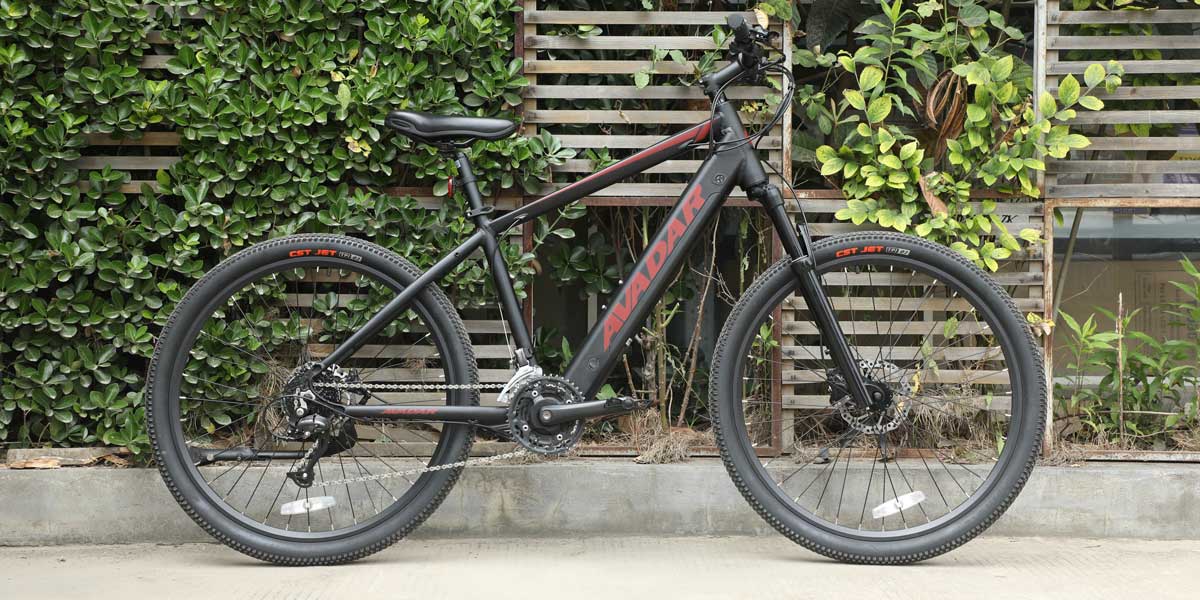
About grip
Look ahead, assess the situation on the roadway, and choose the right time to brake and slow down. If the car is in a straight line, you can brake hard until the rear wheels begin to slide to the side. Put on the necessary protective gear to practice, then practice on the asphalt road, drive slowly – about 10 highways per hour – and then brake only with the front brakes and hold until the rear wheels begin to leave the ground.
If you practice a little, you can learn not to panic when the rear wheel leaves the ground, and more importantly, you can keep the wheel straight, and front roller skating is this action taken to the extreme. If you turn the handlebars while applying the front brake, you may fall over. Because when the front wheel turns, the wheel only relies on a small part of the pattern on the tire to support and grip the ground, if the brake is turned too much, the front wheel probably will not grip the ground enough and will slide out sideways, and the front wheel will slide on its side, and it will fall.
Body position
Except on smooth surfaces such as asphalt roads, do not sit on the saddle when braking on any other surface. Before braking, stand up slightly to get out of the saddle, squat on the bike, and push your body back onto the back of the saddle. This method serves to balance the rear wheel while shifting the center of gravity forward so that it has enough weight to push on the ground.
Slow down the turn
As you learn to use the front brake effectively and ride with the proper amount of rear brake assistance, you will be able to brake harder and harder on corner entry, but it will be unnatural to ride with maximum braking power. Release the brakes when you begin to lean and turn, and release the brakes completely when you have fully negotiated the turn.
Be Careful
Do not think that you never use the front brake when turning, sometimes the ground is very slippery, the grip of the front and rear wheels is very low, in this case you still need to use the front brake, otherwise the rear wheel will slip out sideways as long as you lightly apply the rear brake. And then you have to rely on technique and feel. Experience will tell you how much grip you have before and after, and how much braking power you can use.
Listen
The best way to learn is to feel the braking limit points of the front and rear wheels, and you can also learn to listen. The sound of the tires when they reach maximum grip during braking is completely different. If you hear a soft crackling sound when braking hard, it means that you are approaching maximum braking force; if the crackling becomes a rubbing sound, it means that the tire has started to slip, not roll. When feeling the brakes, pay attention to the sound of the tires, apply the brakes moderately and try not to make a friction noise.
Exceptions
This is especially for mountain bikes, in the sand and other soft soils do not have to use the front brake, let the front wheel roll as easily as possible through the soft sand or gravel, the rear wheel was deep into the ground, with enough grip to slow down and control the speed. Press your body against the rear wheels and let the front wheels float on the surface to improve handling.
But if you are steeply under the sand, the difficulty is even higher! This is where all the training techniques, sensations and conditioned reflexes come into play. Front brakes may be required due to the higher speed, but experience tells you to keep the handlebars straight and feel if the front wheels still have grip. Extend your arms and lean your body back even further. Your fingers should be on the brake handles so that you can adjust the front and rear brake forces at any time to maintain balance and the running line.
In general, the sixth sense of braking is to sense whether the wheels have reached the limit of grip. Learn to automatically adjust the front and rear brakes to the ground conditions in front of you, and learn to feel the grip of the wheels on the brake handles. But these techniques and feelings can not be learned all at once, but require constant practice and experience, as well as the accumulation of experience. As long as you usually ride a bike with more eyes and more practice, I believe that soon, you can also master the correct use of the brakes, the best result is to be able to use the brakes more effectively, less likely to lose control, and less likely to have accidents.
